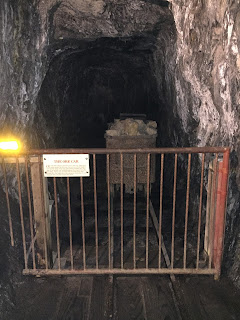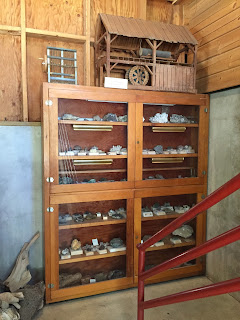After our pie making field trip, we stopped at the Gold Bug Mine on our way home.
I had never been here before, and I'm glad we took the time to visit. We had a snack at the picnic grounds, and then went upstairs to start the mine tour.
Upstairs were many interesting types of rock, including some we could handle. Pumice is sharp!
After we paid for our tour, the docent instructed me to download their app on my phone, which would guide us through the mine. Very cool!
Outside the mine entrance. This was really a neat experience for all of us, but since Jack and I got to visit another, currently active, gold mine earlier this summer, I think we got more out of it, by being able to compare the two mines.
Jack took this picture for me, just inside the entrance. You can see sunlight behind us a few yards back. I have a thing for touching old rocks.
Deeper inside the mine, looking straight up. That beam wedged between the walls was there to help stablize things, but also for the miners to STAND ON. Yikes. This led to an air shaft to help ventilate the mine.
The walls were amazingly pretty, with sudden color changes like this one.
You can see stalactites beginning to form from the water dripping and leaving mineral deposits on the ceiling.
Pretty green. I don't know if it's a surface color, like from something growing on the outside of the rock, or if that's the rock itself, some kind of mineral. But it was neat to look up at.
So here we are, going from number to number, inside the mine, at the instruction of the "ghost miner" in the app.
You can see the number 2 here. There were 13 stops altogether.
And this was why I was wearing a hard hat and the children were not. Anybody taller than the line in the gift shop has to wear a hat.
Although I know that gold mining and coal mining are not the same, being inside reminded me a little of the coal mining scenes I've watched on When Calls the Heart.
Gold Bug has not been an active mine for many years, but it still looks as though miners could come whistling up the path at any moment, with a pickax over one shoulder and a lunch pail in the other hand.
This was a side branch that was not open to visitors.
There were a couple of old mine cars, which really added to the ambiance. They've added a wooden floor to the mine, over the tracks, but you can still see the tracks in the side branch and behind the gate below.
This was the end of the mine shaft.
This mine car was full of rocks, ready to be pushed out and taken to the mill.
Behind the mine car, you can see fuses coming out of holes in the wall, ready to be lit to blow another 3' or so to the end of the tunnel. That won't happen, of course, because this is a historic park, but it gives you the idea of what things were like when this was an active mine.
After the mine portion of the tour, we drove up the hill to the stamp mill and blacksmith shop.
Volunteer blacksmiths act as docents, showing how things were forged in the old days. They explained how square nails were made, as well as chain links.
There were many things to see and touch here.
This shot reminded me of my grandfather's work space. Everything in it's place, lots of old/vintage tools.
One of the kind docents asked if we had a few minutes so he could make us a salt spoon out of a nail. Yes, of course! This is the nail before.
He heated it in the forge, pounded on it, heated it some more...
This device shaped the bowl of the spoon. There's a rounded edge at the bottom of the shaft he's pounding that makes the flattened head of the nail into a curve.
He showed us this part, then turned the spoon to be around in his pliers and went back to heating it, twisting the handle, heating it again, twisting it at the tip.
When he was finished, he plunged it into a bucket of water to cool it.
And here's the finished salt spoon! Even the teens at home thought it was cool when we showed it to them later that night.
This is part of the massive stamp mill. Water used to turn the large wheel on the left, which turned the shaft the cams are attached to. The cams raise and lower the giant stamps twice per second, crushing the rock to powder.
This shows the stamps, and the docent in this room clunked the one on the left for us so we could get an idea of the deafening noise of a functioning stamp mill. You feel the noise. I'm glad Eli was not with us, because I'm sure it would have hurt his (recently concussed) head.
However, I did wish Eli was there for all the cool rocks we got to see!
Cases and cases of cool rocks. Also, see the model of the mill?
They also had a miniature version of the stamp mill so the kids could better understand how it worked. The guide turned it on for a minute so the kids could see it going up and down and hear the clatter.
He explained that the powdered rock would be spread over a layer of mercury, which acts like a magnet to the gold flecks. It really gives you an appreciation for the value of gold, when you begin to understand the incredible lengths people went to, to blast and dig and haul and carry and crush and process tiny little bits of gold--and all that effort was profitable.
The guide's hat is between two posters on the back wall. The poster on the left explains how the gold was separated from the mercury and the mercury was recycled. This mill could not adequately purify the gold because they couldn't heat it hot enough here, so it would be taken to San Francisco for finishing.
Which brings us to... Stage coaches, and robbers, like Black Bart! The guide here did a bit of acting as he told us how he, Black Bart, robbed 29 stagecoaches with an unloaded gun! In an interesting twist of the story, Wells Fargo actually got him out of prison early, hoping to keep him from going back to robbing stagecoaches after his release. He disappeared, and some people think he dug up money that he had stashed from prior robberies (only the 29th take was recovered when he was arrested) and lived happily ever after somewhere else.
This was a great field trip for us right now, as we're studying California history this year, and this was a great look at real, semi local history. It was also really interesting and fun. I'm so glad that we stopped! I've driven past the sign each year when we visit Apple Hill. Now I'm feeling inspired to seek out more "hidden treasures" in our area.
As we were leaving, a dear came down one of the hiking trails and crossed the parking lot in front of us. Jack captured this picture of him right before we hopped in the van to head home.
The kids were giving me grief for not wanting to hike the trails (mind you, this is after our morning pie making field trip, and all the fun at Gold Bug). I suspected that Hannah and Katie would have a hard time with the uneven terrain of the trail, and I was put off by the poison oak signs, so I said no. Turns out, Jack and Hannah both crashed out on the way home, and Jack said when he woke up, "It's a good thing we didn't go hiking."
This post may be linked up at these linky parties.





































Wow! That sounds so neat! My oldest son wants to be a gold miner and my middle son does a bit of blacksmithing now and then; they'd love this trip!
ReplyDeleteIt really was a neat trip. I feel like I discovered a treasure, since we've driven by it several times, but never thought to stop there. We also got to tour an active gold mine in July: http://grtlyblesd.blogspot.com/2016/07/gold-mine-tour.html
Delete